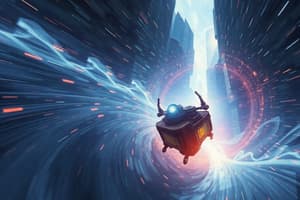Podcast
Questions and Answers
Consider a scenario involving a spacecraft maneuvering near a supermassive black hole. Given the principles of general relativity and the inverse square law of gravitation, which of the following adjustments to the spacecraft's trajectory would most effectively minimize tidal forces experienced by the spacecraft?
Consider a scenario involving a spacecraft maneuvering near a supermassive black hole. Given the principles of general relativity and the inverse square law of gravitation, which of the following adjustments to the spacecraft's trajectory would most effectively minimize tidal forces experienced by the spacecraft?
- Increasing the spacecraft's albedo to reduce radiative pressure from the accretion disk.
- Modulating the spacecraft's trajectory to orbit at the innermost stable circular orbit (ISCO) while utilizing advanced gravitational shielding.
- Employing quantum entanglement-based communication to anticipate gravitational anomalies.
- Maximizing the spacecraft's proper acceleration while maintaining a constant Schwarzschild radius relative to the black hole. (correct)
A research team is designing a novel triboelectric nanogenerator (TENG) that relies on maximizing static friction at the interface between two dissimilar materials. To optimize the TENG's performance in a high-humidity environment, which of the following surface modification strategies would be most effective in maintaining high static friction?
A research team is designing a novel triboelectric nanogenerator (TENG) that relies on maximizing static friction at the interface between two dissimilar materials. To optimize the TENG's performance in a high-humidity environment, which of the following surface modification strategies would be most effective in maintaining high static friction?
- Creating a hierarchical micro/nanostructured surface with hydrophobic coatings to minimize the contact area with water. (correct)
- Introducing a thin film of ionic liquid to enhance interfacial charge transfer and reduce surface energy.
- Employing a sacrificial polymer coating that degrades over time, creating a self-roughening effect and increasing real contact area.
- Applying a self-assembled monolayer (SAM) of amphiphilic molecules to promote water condensation and capillary bridging.
In the context of computational fluid dynamics (CFD), consider a simulation of airflow around an airfoil at a high Reynolds number. Which turbulence model would most accurately predict the onset of flow separation and the resulting pressure drag due to fluid friction?
In the context of computational fluid dynamics (CFD), consider a simulation of airflow around an airfoil at a high Reynolds number. Which turbulence model would most accurately predict the onset of flow separation and the resulting pressure drag due to fluid friction?
- The k-epsilon (k-$\epsilon$) model with standard wall functions, given its robustness and wide range of applicability.
- The Spalart-Allmaras model, due to its computational efficiency and suitability for attached boundary layers.
- The Large Eddy Simulation (LES) model, when combined with a wall-adapting local eddy-viscosity (WALE) subgrid-scale model, to capture near-wall turbulence. (correct)
- The Reynolds Stress Model (RSM), owing to its ability to resolve anisotropic turbulence and streamline curvature effects.
Imagine a scenario where a team is developing a magnetic levitation (Maglev) system for high-speed trains. To minimize energy losses due to eddy current damping as the train moves, which strategy is most effective for designing the guideway's electromagnetic properties, assuming a constant train speed and magnetic field strength?
Imagine a scenario where a team is developing a magnetic levitation (Maglev) system for high-speed trains. To minimize energy losses due to eddy current damping as the train moves, which strategy is most effective for designing the guideway's electromagnetic properties, assuming a constant train speed and magnetic field strength?
Consider a scenario involving the design of a microfluidic device for high-throughput chemical screening. To minimize non-specific protein adsorption on the channel walls, thereby reducing electrical double layer interference, which surface modification technique would be most effective in this scenario?
Consider a scenario involving the design of a microfluidic device for high-throughput chemical screening. To minimize non-specific protein adsorption on the channel walls, thereby reducing electrical double layer interference, which surface modification technique would be most effective in this scenario?
A team of engineers is tasked with designing an ultra-sensitive gravimeter for detecting subtle variations in the Earth's gravitational field caused by deep subsurface geological formations. Which of the following advanced technologies would provide the highest precision and resolution for this application?
A team of engineers is tasked with designing an ultra-sensitive gravimeter for detecting subtle variations in the Earth's gravitational field caused by deep subsurface geological formations. Which of the following advanced technologies would provide the highest precision and resolution for this application?
Consider a scenario where a spacecraft is orbiting a rapidly rotating neutron star with an intense magnetic field (magnetar). Which relativistic effect would most significantly influence the spacecraft's trajectory and require precise modeling for accurate navigation?
Consider a scenario where a spacecraft is orbiting a rapidly rotating neutron star with an intense magnetic field (magnetar). Which relativistic effect would most significantly influence the spacecraft's trajectory and require precise modeling for accurate navigation?
A team is developing a novel haptic feedback system that relies on electrostatic friction modulation to simulate realistic textures on a touchscreen. Which of the following factors would most critically limit the achievable spatial resolution and fidelity of the haptic rendering?
A team is developing a novel haptic feedback system that relies on electrostatic friction modulation to simulate realistic textures on a touchscreen. Which of the following factors would most critically limit the achievable spatial resolution and fidelity of the haptic rendering?
Consider a scenario where you are analyzing the frictional behavior of a novel composite material designed for use in high-speed rail braking systems. The material exhibits a complex interplay between adhesion, abrasion, and tribochemical reactions at the contact interface. Which advanced analytical technique would provide the most comprehensive insights into the dominant wear mechanisms and the evolution of the tribological contact?
Consider a scenario where you are analyzing the frictional behavior of a novel composite material designed for use in high-speed rail braking systems. The material exhibits a complex interplay between adhesion, abrasion, and tribochemical reactions at the contact interface. Which advanced analytical technique would provide the most comprehensive insights into the dominant wear mechanisms and the evolution of the tribological contact?
Imagine you are tasked with optimizing the performance of a micro-electro-mechanical system (MEMS) gyroscope. Which of the following strategies would most effectively mitigate the impact of Brownian motion on the gyroscope's sensitivity and accuracy?
Imagine you are tasked with optimizing the performance of a micro-electro-mechanical system (MEMS) gyroscope. Which of the following strategies would most effectively mitigate the impact of Brownian motion on the gyroscope's sensitivity and accuracy?
Flashcards
Force Definition
Force Definition
A push or pull on an object.
Contact Force
Contact Force
A force that requires direct contact between objects.
Non-Contact Force
Non-Contact Force
A force that acts between objects without direct contact.
Friction
Friction
Signup and view all the flashcards
Static Friction
Static Friction
Signup and view all the flashcards
Sliding Friction
Sliding Friction
Signup and view all the flashcards
Fluid Friction
Fluid Friction
Signup and view all the flashcards
Gravity
Gravity
Signup and view all the flashcards
Mass
Mass
Signup and view all the flashcards
Mass and Gravity
Mass and Gravity
Signup and view all the flashcards
Study Notes
- Forces change the motion of an object.
Contact Forces and Non-Contact Forces
- Contact forces and non-contact forces can impact the motion of objects.
Law of Universal Gravitation
- The law of universal gravitation is a key concept.
Friction
- Friction affects the motion of two objects sliding past each other.
Force
- A force is a push or a pull on an object.
- There are two types of forces: contact and non-contact.
Contact Force
- A push or pull on one object by another that is touching it.
- Examples include pushing a container, pressing on computer keys, and friction.
Non-Contact Force
- A push or pull on one object by another without touching it.
- Examples include: gravity, magnetic, and electrical forces.
Friction
- Friction is a force that resists the motion of two objects that are touching.
- There are 3 types of friction: static, sliding, and fluid.
Static Friction
- Prevents objects from sliding past each other.
Sliding Friction
- Sliding friction opposes the motion of objects sliding past each other.
Fluid Friction
- Friction between a surface and a fluid such as water or air, like air resistance.
Static Friction Example
- Static friction -100N + Applied force 100N = Net Force of 0N
Sliding Friction Example
- Sliding friction -70N + Applied force 200N = Net Force
Gravity
- An attractive force that exists between all objects that have mass.
Mass
- Refers to the amount of matter in an object.
- The more mass, the more gravitational pull.
Distance
- The greater the distance, the less gravitational pull.
Weight
- The amount of gravitational force exerted on an object and is measured in newtons.
- If an astronaut weighs 539N and has a mass of 55kg on Earth, her weight would be less if she was on the moon.
Static Charge
- An unbalanced positive or negative charge on an object.
- Opposite charges attract each other.
- The same charges repel each other.
- The more charge, the greater the electrical force (attractive or repulsion).
- The more distance, the less electrical force.
Magnet
- Object that attracts metal iron.
Magnetic Pole
- A place on a magnet where the force it applies is the strongest.
- Opposite poles (charges) attract each other.
- The same poles (charges) repel each other.
- Size of the magnet impacts magnetic strength.
- Distance: The further away the magnets are the weaker the magnetic force
Studying That Suits You
Use AI to generate personalized quizzes and flashcards to suit your learning preferences.




